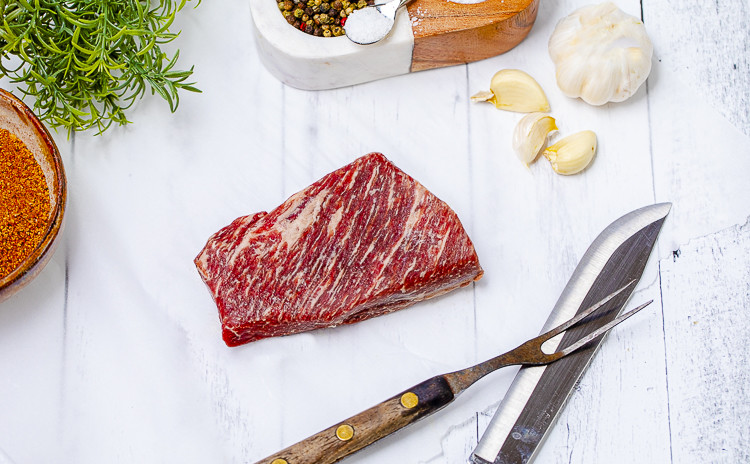Preparation Methods
posted on
April 17, 2019
Steaks

Roasts

Misc


Grilling:
Turn on grill to medium heat. Season grill with a light coat of vegetable oil. Season steaks with salt and pepper or your favorite rub.
Place steak on hot grill, close lid and allow to cook for 2 minutes. Lift steak off the grill, turn 45 degrees and place back on the grill. Allow to cook 2 more minutes.
Turn steak over and cook for 2 minutes. Lift steak off the grill, turn 45 degrees and place back on the grill. Allow to cook for 2 more minutes. For medium rare, the total cook time is 8 minutes. Check the temperature of the thickest part of the steak to determine when it is done to your preference. See chart for temperature guidelines.
Remove steaks from the skillet and cover loosely with aluminum foil. Let stand 5 minutes. The steaks continue to cook the temperature will rise about 5 degrees. Serve.
Steakhouse Method:
- Pre-heat oven to 350℉. Heat a cast iron skillet over medium-high heat until hot. Add a thin layer of your favorite cooking oil. Season steaks with salt and pepper (or your favorite seasoning blend). Place steaks in skillet.
- Sear steaks for 4 mins, turning once. If a steak sticks to the skillet, it's not ready to turn. Wait until it releases on its own.
- Place skillet in a 350 degree pre-heated oven for 10-20 mins, depending on desired doneness. Turn once halfway through cooking time. Remove from oven when preferred internal temp. is reached.
- Remove steaks from skillet and tent loosely with aluminum foil. Let stand 5 mins before serving. The temp will continue to rise ~5 degrees.
*Recommended for steaks 1.5" or thicker, which is why this method has only been recommended for the filet mignon.*
Pan Searing:
Heat a heavy skillet (cast iron is ideal) over medium heat until hot. Add a light coat of vegetable oil to the skillet. Season top side of steaks with salt and pepper.
Place steaks, seasoned side down, in skillet and sear 4 to 5 minutes until nicely browned. Season the top side of the steak with salt and pepper. If the steak sticks to the skillet, it’s not ready to turn. Wait until it releases on its own.
Turn steaks over and allow to cook for an additional 3 to 5 minutes. After 2 to 3 minutes, use a thermometer to test the thickest part of the steak. When the temperature reaches the desired level, remove from the skillet. Remove steaks from a skillet and serve.
*Recommended for steaks 1.25" or thinner. Since most of our steaks are 1" thick, most turn out really well with a quick pan sear!*
Reverse Sear:
Heat oven to 275 degrees. Season steak with salt and pepper. Cover a baking sheet with foil and place a metal rack in the middle. The idea is to elevate the steak from the pan.
Place the pan, rack and steak in the oven. Bake until the steak reaches the temperature that matches your preference. See the chart for exact temperatures. For medium rare, cook until 120 degrees. This can take up to 60 minutes, but begin checking the internal temperature at 30 minutes.
Remove steak from oven, loosely cover with foil and allow to rest for 10 to 15 minutes.
Add a light coating of vegetable oil to a heavy skillet and heat over high heat until hot. Sear steak on each side for 60 to 90 seconds to form a beautiful crust. Serve.
*Reverse sear can also be done with the smoker. See this blog post for those cooking instructions!*
Sous Vide:
For a steak:
- Place your immersion circulator in a container with water and set the temperature. See the chart to determine the best temperature to achieve the result you desire.
Use a generous amount of salt and pepper on both sides of the steak.
Use a vacuum sealer to seal the steak in a bag. You can also use a self-sealing plastic bag by placing the bag in a container of water, being careful to keep the lid above the water line. The water pressure will displace the air as the steak drops deeper into the water. Seal the bag when all or most of the air has been pushed out of the bag.
Place the sealed bag into the water. We recommend cooking your steak a minimum of one hour and no longer than two hours.
Add a light coat of vegetable oil to a heavy skillet. Place on a burner set to medium-high heat.
Remove the steak from the sealed bag. Pat the steak dry and place in the hot pan. Cook about 1 to 2 minutes per side to create a brown, crisp crust. Steaks cooked sous vide do not require resting so you can serve immediately.
For a Roast:
Braising:
Roasting:
Preheat oven to 350℉. Remove roast from packaging and season generously with salt and pepper or your favorite rub. Place seasoned rub fat side up on a rack in a roasting pan. Do not cover roast or add water.
Roast in oven at 350℉ and refer to the chart below for approx. cooking times. Remove roast from oven when internal temperature reaches 130℉ for medium rare or 135℉ for medium doneness. Use a meat thermometer to ensure roast is cooked to preferred doneness.
Transfer to carving board and tent loosely with aluminum foil. Let stand 15-20 mins. Temperature will continue to rise about 10℉.

Smoking:
Instant Pot:
Slow Cooking:




